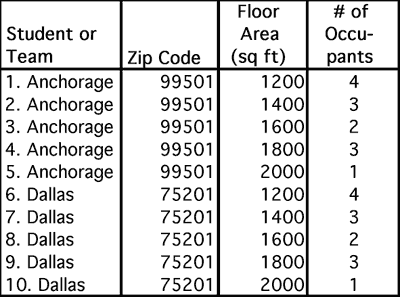|
|
|
|
|||
|
|
|
|
|
|
|
|
||
|
|
Teachers' Guide: Getting StartedSynopsis: In Part I, the students are divided into two groups and directed to create houses in either Anchorage (cold climate) or Dallas (hot climate). The teacher should provide the relevant zip codes (99501 and 72501, respectively). Each student/team has a unique building (defined by a particular combination of floor area and number of occupants) and hence arrives at a different energy use result. The results are graphed as a group and the results discussed. In Part II, the students make the house larger and record the increased energy use. The students then explore ways to reduce energy in this enlarged home, hopefully to a level even below that of the original (smaller) house. Results are compared again, as a group. In Part III, the students graph the cumulative energy bills over a period of five years, identifying the point at which the investment (set at $500) in making the home more energy efficient is paid back in energy savings. Simple linear formulas for these lines are developed and manipulated. This lesson covers the following five conceptual areas:
The material deals with the following specific issues and skills:
Ways of using this materialThe student's version of the lesson is here and an annotated teacher version is here. We have provided a spreadsheet here for analyzing and graphing the results. The expected answers are included in the spreadsheet. A copy with blank data-entry cells, which are shown in a bold blue font in the example, (taking care to retain important formulas and charts for analysis) should be made for use in class. A sheet of graph paper should be provided for Part III. The material involves a three periods of individual (or team) work and two or more periods of group comparison and discussion of the results. The materials are designed for 10 students or teams. Each student/team should be assigned one of the following locations, house sizes, and occupancies. Although we have used the numbers 1-10 here, we have found that students enjoy naming their teams. Names can be plugged into the spreadsheet and will show up on the resulting charts and tables. 
This lesson can be used in a single intensive classroom session, although a minimum of two hours is probably required. Alternatively, the lesson can be spread over several classroom sessions (e.g. one for each "Part"). Assessment QuizWe have provided a Quiz to assess student knowledge of the material. The questions refer back to the five key concepts described above, as well to the specifics learned from the three parts of the lesson. An answer key is also available here. The Assessment Quiz was tested on a group of 16 participants, administered before and after the lesson. The results can be found here. This test was based on a "condensed" lesson of only 1.5 hours. Given the short time devoted, the tendency for scores to improve from pre- to post-lesson is of particular note. |
|
|
|||||||||||||||||||||||||||||||||||||||||||||
|
|
|
|
|||||||||||||||||||||||||||||||||||||||||||||||

|

|

|

|

|
|
Introduction |
Students |
Teachers |
Credits Contact | Webmaster |